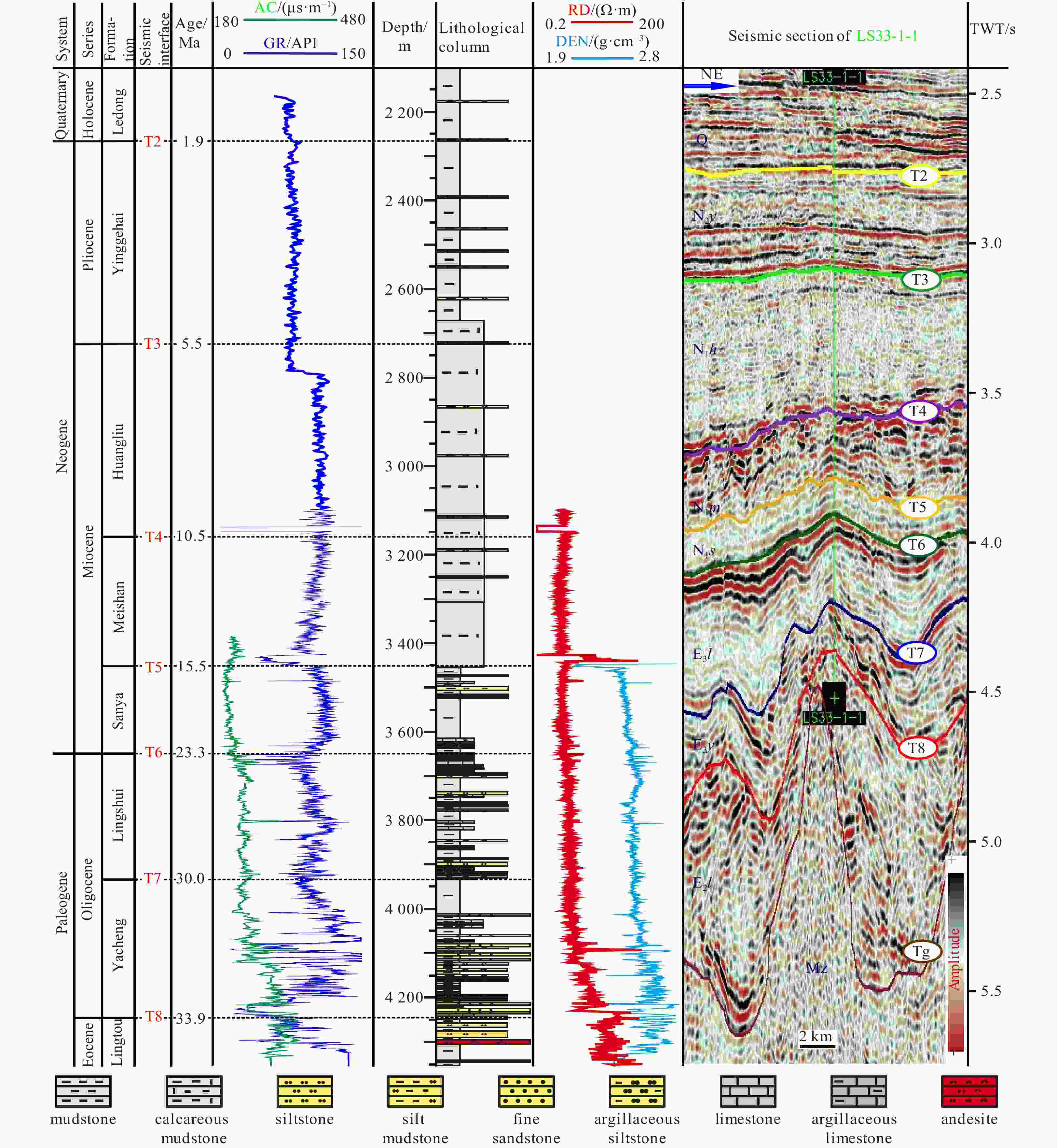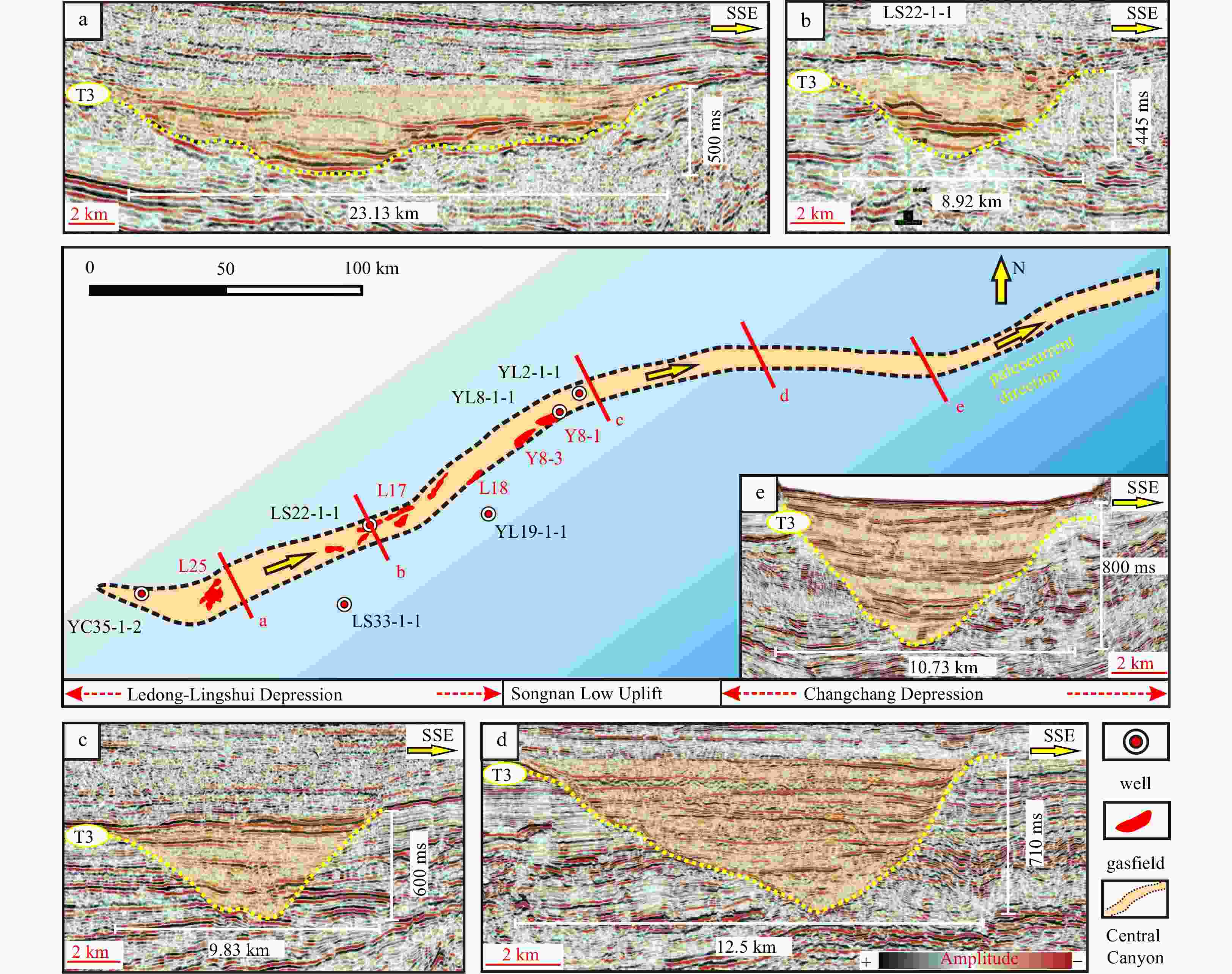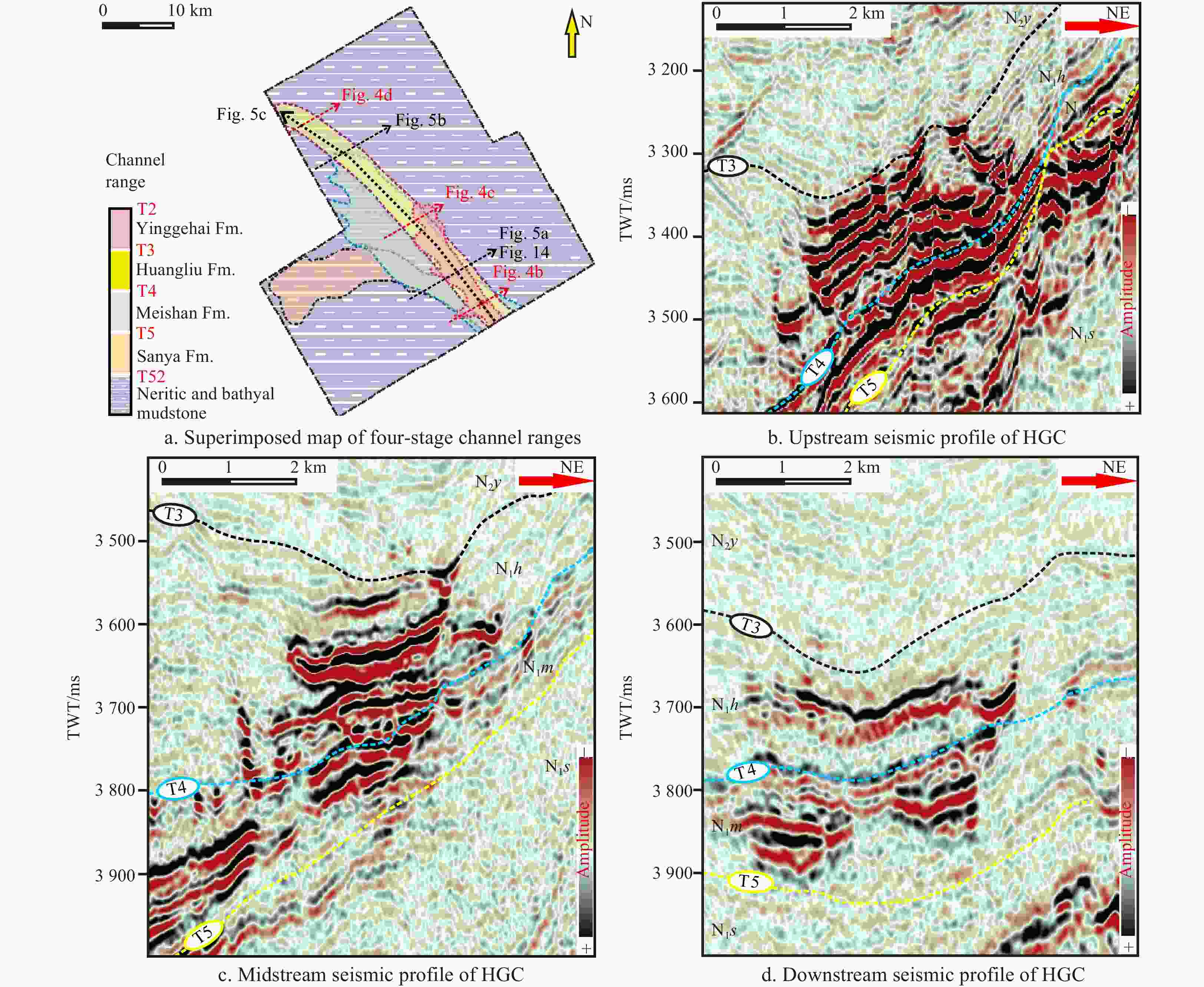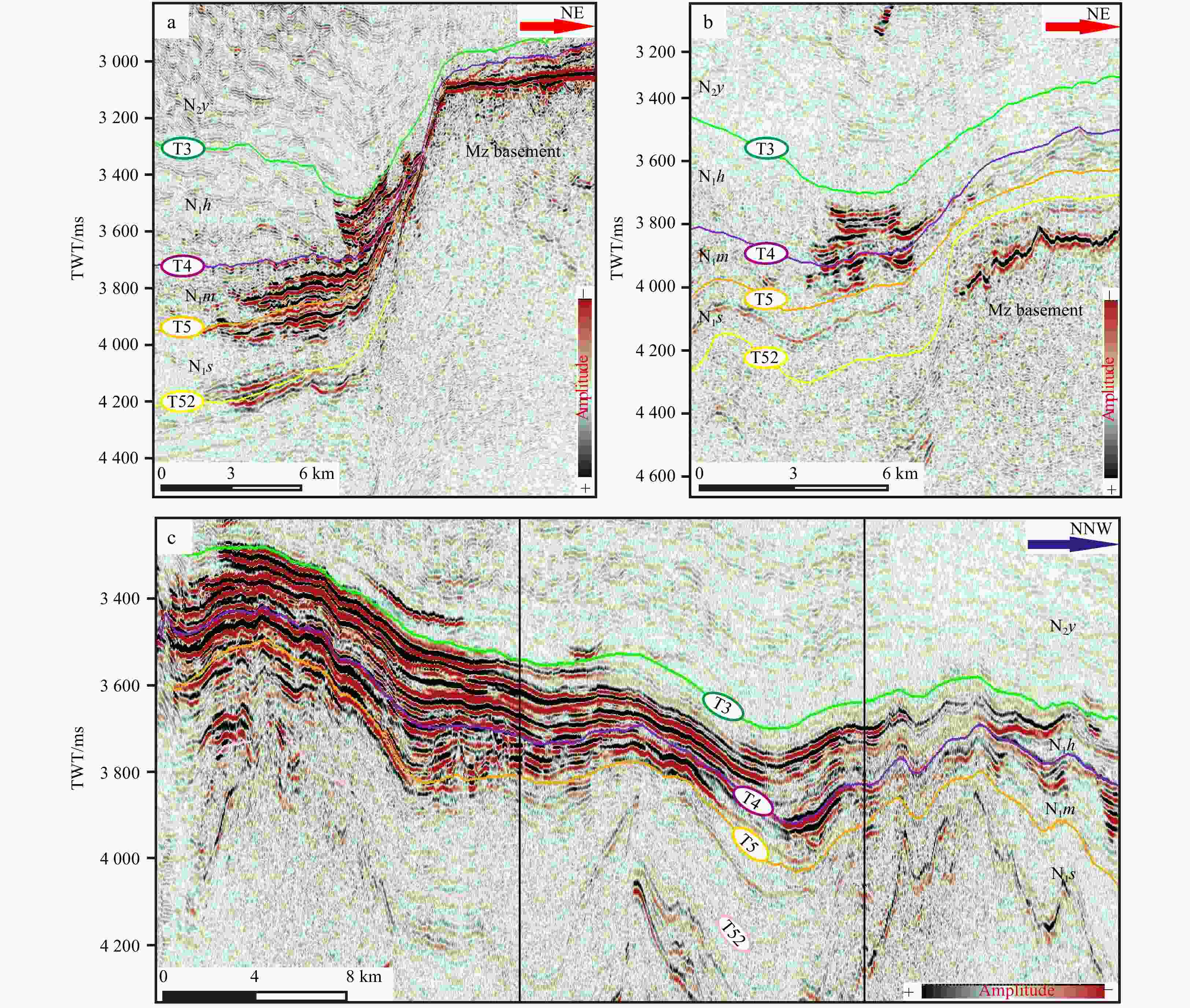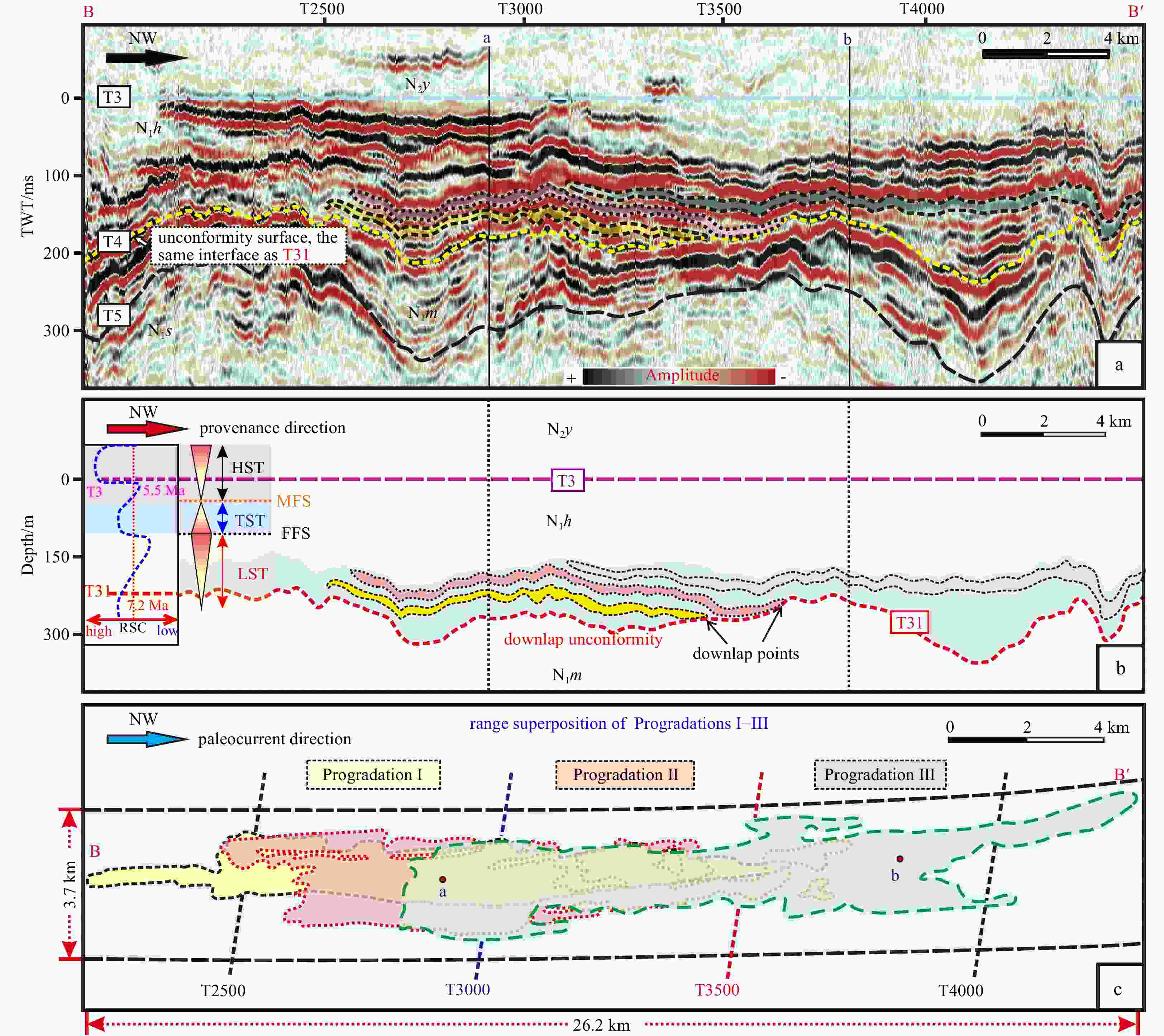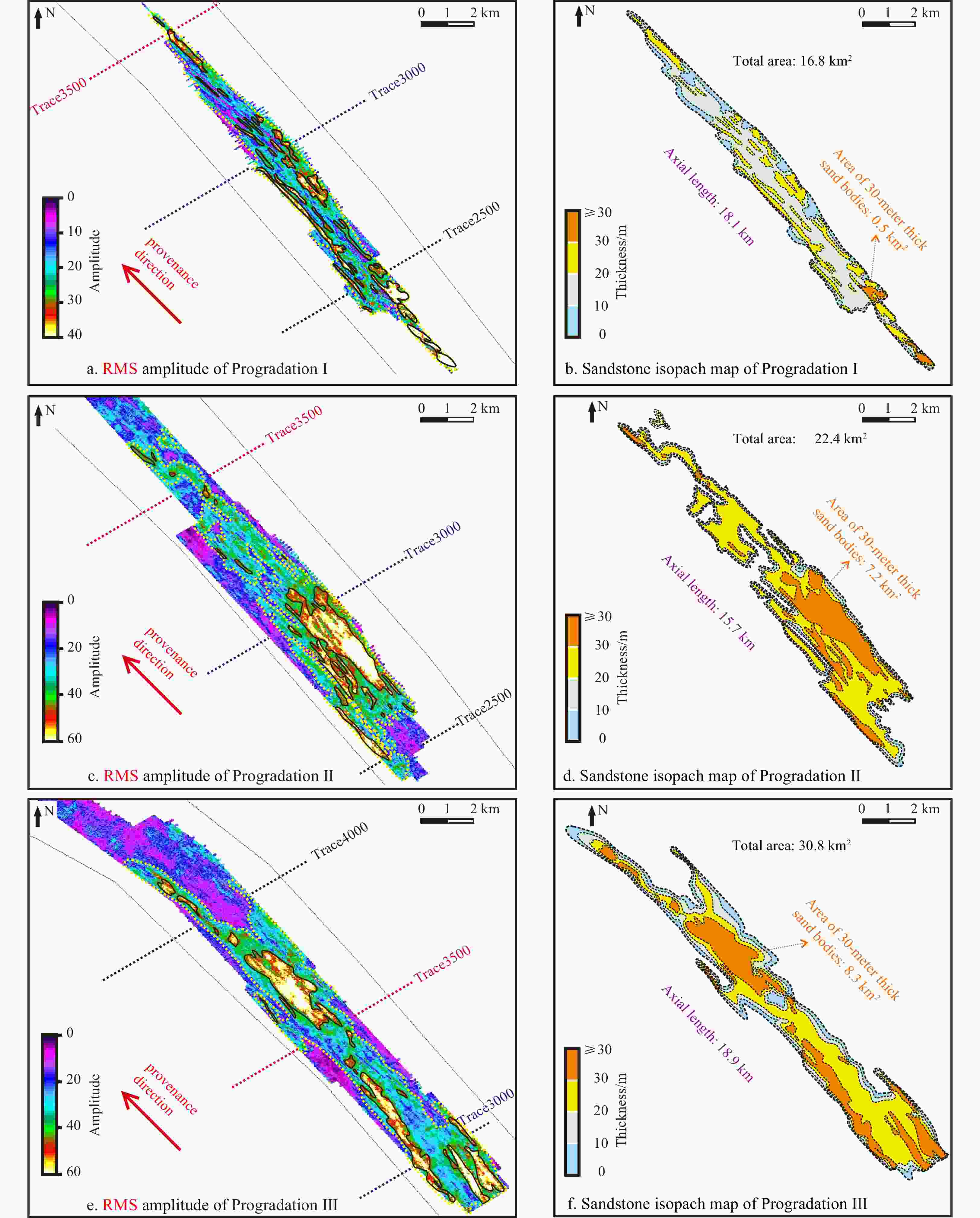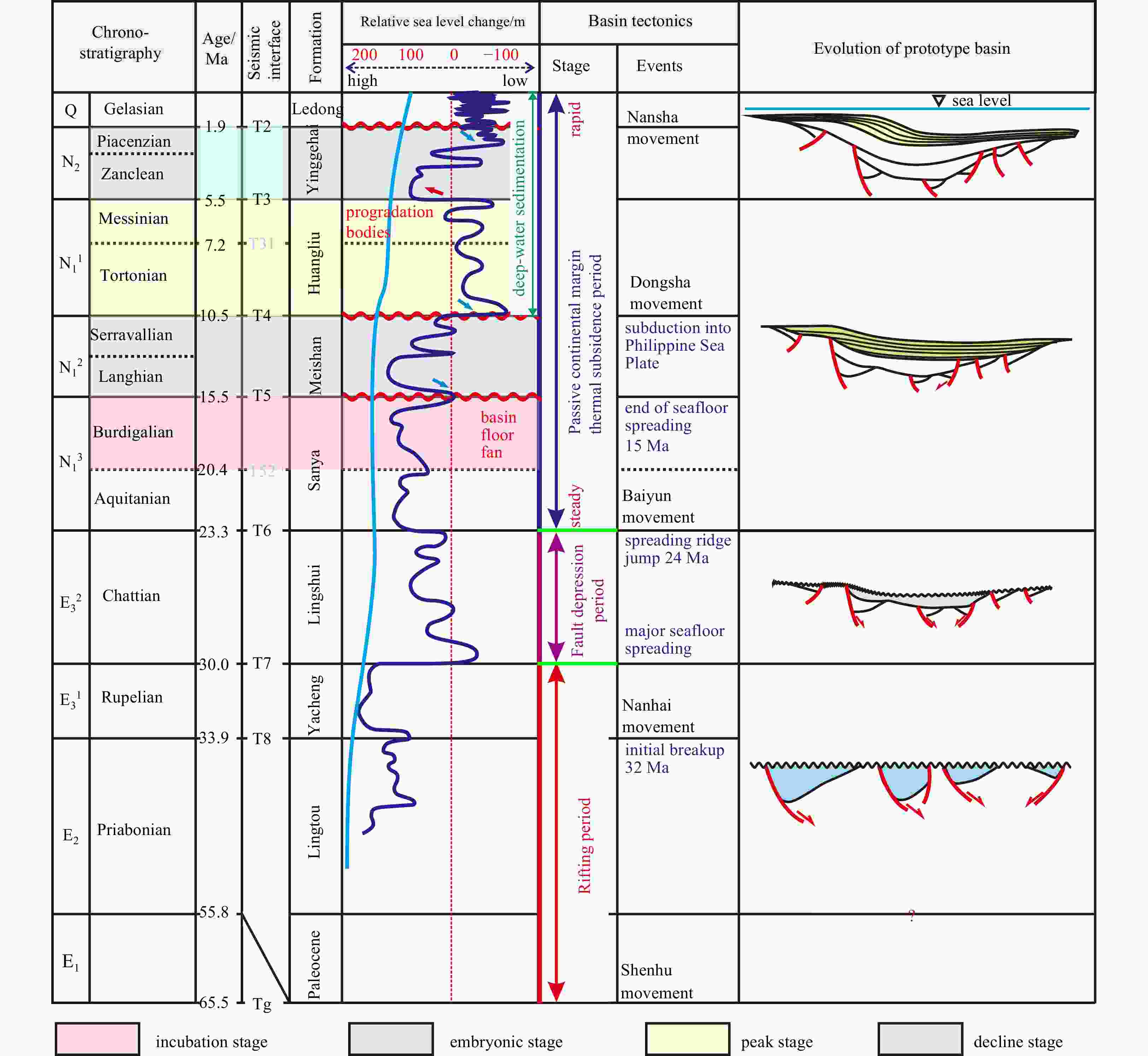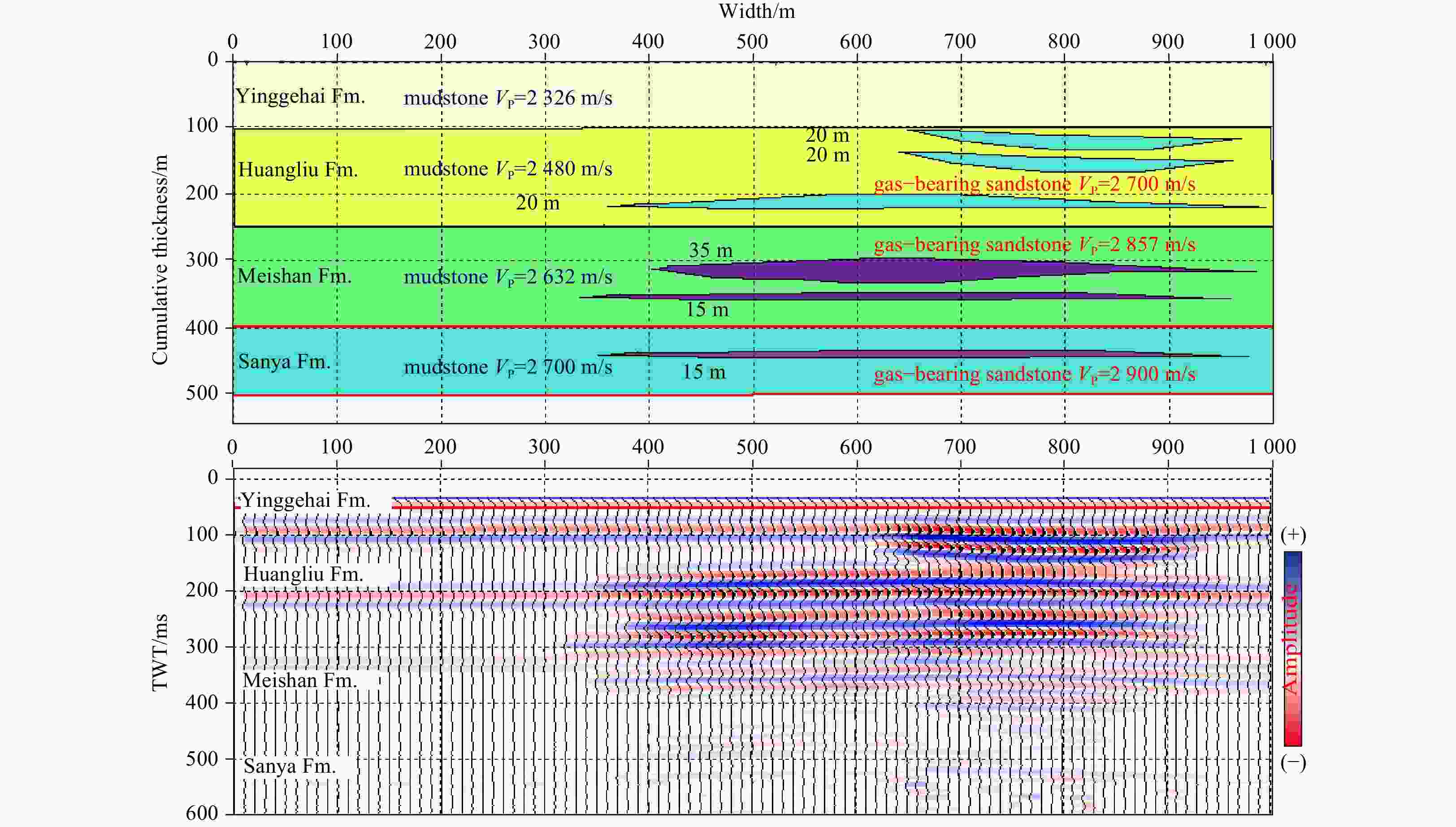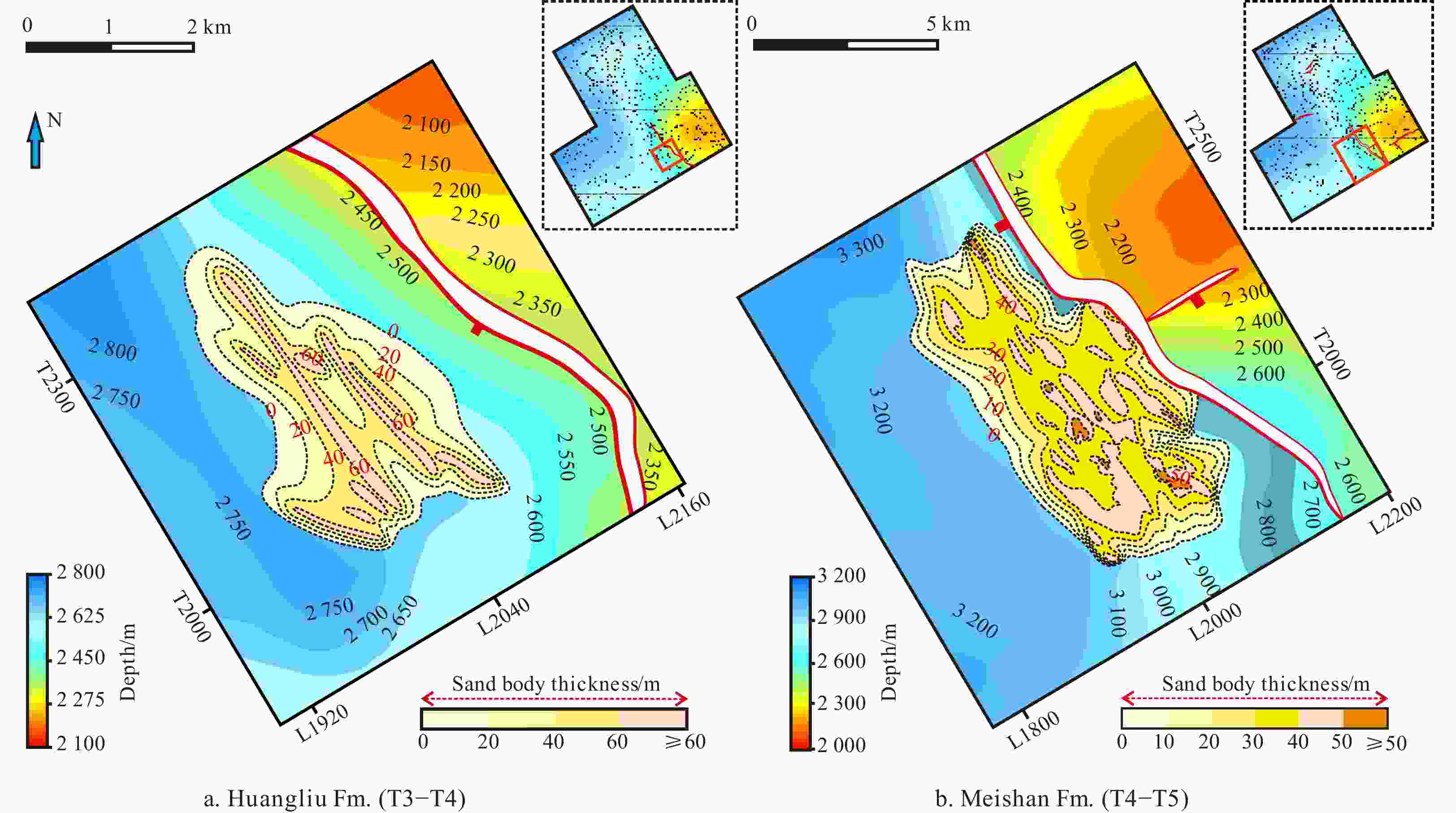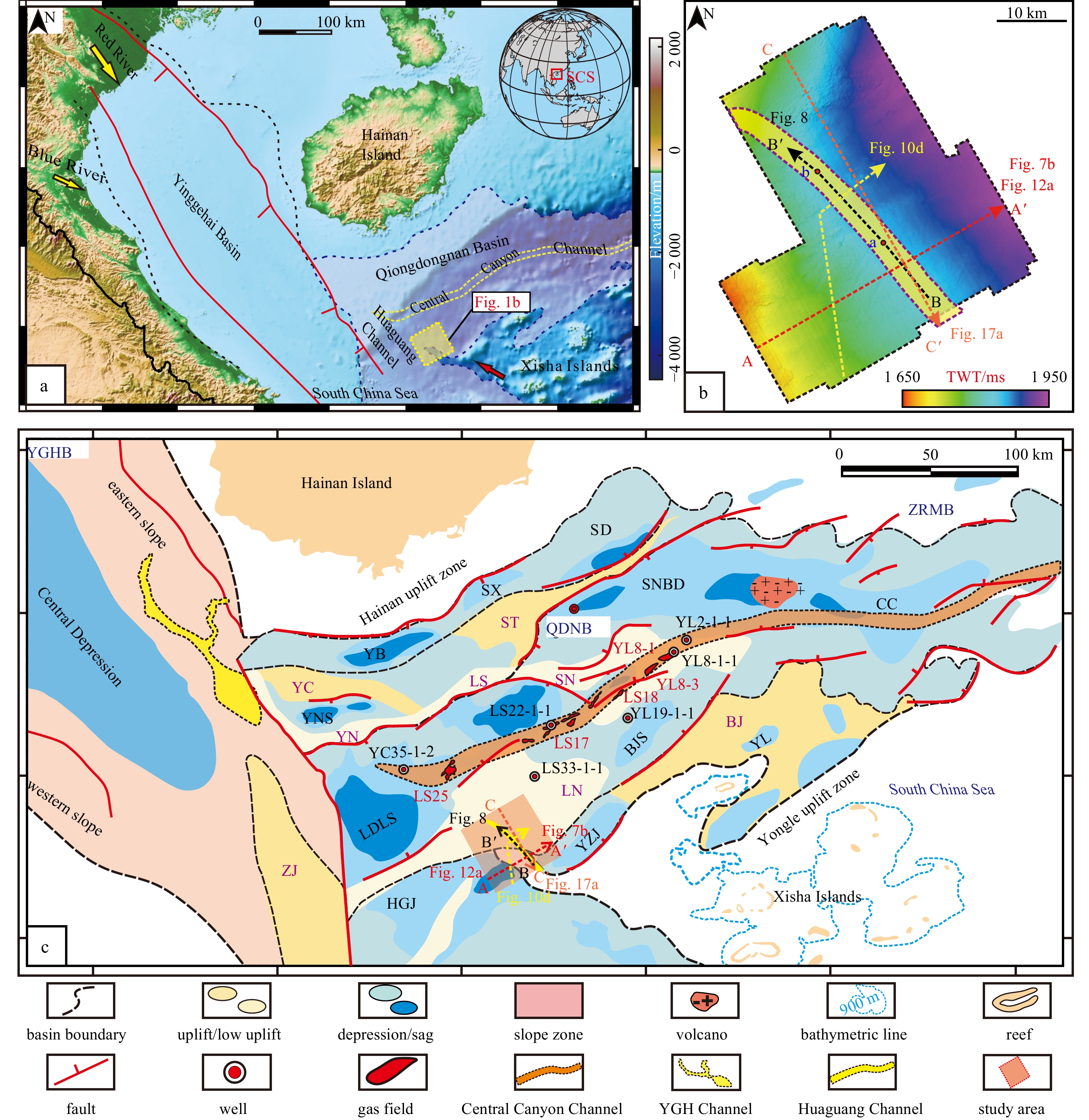Genesis, evolution and reservoir identification of a Neogene submarine channel in the southwestern Qiongdongnan Basin, South China Sea
-
Abstract: A rarely reported middle−late Miocene−Pliocene channel (incised valley fill), the Huaguang Channel (HGC), has been found in the deep-water area of the southwestern Qiongdongnan Basin (QDNB). This channel is almost perpendicular to the orientation of another well-known, large, and nearly coeval submarine channel in this area. Based on the interpretation of high-resolution 3D seismic data, this study describes and analyzes the stratigraphy, tectonics, sedimentation, morphology, structure and evolution of HGC by means of well-seismic synthetic calibration, one- and two-dimensional forward modeling, attribute interpretation, tectonic interpretation, and gas detection. The HGC is located on the downthrown side of an earlier activated normal fault and grew northwestward along the fault strike. The channel is part of a slope that extends from the western Huaguang Sag to the eastern Beijiao Uplift. The HGC underwent four developmental stages: the (1) incubation (late Sanya Formation, 20.4–15.5 Ma), (2) embryonic (Meishan Formation, 15.5–10.5 Ma), (3) peak (Huangliu Formation, 10.5–5.5 Ma) and (4) decline (Yinggehai Formation, 5.5–1.9 Ma) stages. The channel sandstones have a provenance from the southern Yongle Uplift and filled the channel via multistage vertical amalgamation and lateral migration. The channel extended 42.5 km in an approximately straight pattern in the peak stage. At 10.5 Ma, sea level fell relative to its lowest level, and three oblique progradation turbidite sand bodies filled the channel from south to north. A channel sandstone isopach map demonstrated a narrow distribution in the early stages and a fan-shaped distribution in the late stage. The formation and evolution of the HGC were controlled mainly by background tectonics, fault strike, relative sea level change, and mass supply from the Yongle Uplift. The HGC sandstone reservoir is near the Huaguangjiao Sag, where hydrocarbons were generated. Channel-bounding faults and underlying faults link the source rock with the reservoir. A regionally extensive mudstone caprock overlies the channel sandstone. Two traps likely containing gas were recognized in a structural high upstream of the channel from seismic attenuation anomalies. The HGC will likely become an important oil and gas accumulation setting in the QDNB deep-water area.
-
Key words:
- South China Sea /
- Qiongdongnan Basin /
- submarine channel /
- channel evolution /
- reservoir identification
-
Figure 1. Map of the regional location of the study area, the location of the relevant area and the division of tectonic units in the Qiongdongnan Basin. a. The background map is the current bathymetric map of the South China Sea, the yellow area is the location of the study area, and the yellow dotted line is the Central Canyon Channel. b. Seafloor isochronic map of the 3D seismic survey and the Huaguang Channel distribution of the Huangliu Formation. c. Structural unit map of the Qiongdongnan Basin, with the distribution of typical submarine channels and gas fields in the South China Sea. BJ: Beijiao Uplift, BJS: Beijiao Sag, CC: Changchang Sag, HGJ: Huaguangjiao Sag, LDLS: Ledong-Lingshui Sag, LN: Lingnan Low Uplift, LS: Lingshui Uplift, ZRMB: Zhujiang River Mouth Basin, QDNB: Qiongdongnan Basin, SD: Songdong Sag, SN: Songnan Uplift, ST: Songtao Uplift, SX: Songxi Sag, YB: Yabei Sag, YC: Yacheng Uplift, YGHB: Yinggehai Basin, YL: Yongle Sag, YN: Yanan Low Uplift, YNS: Yanan Sag, YZJ: Yuzhuojiao Sag, ZJ: Zhongjian Uplift.
Figure 2. Lithologic column, Well LS33-1-1 and cross-well seismic profile in the northern part of the study area (modified from Liu et al. (2018)).
Figure 4. Superposition map of the Huaguang Channel (HGC) at different stages and with seismic profiles of the upper, middle and lower reaches of the cross-channel in the southwestern Qiongdongnan Basin. N1s: Sanya Formation; N1m: Meishan Formation; N1h: Huangliu Formation; N2y: Yinggehai Formation.
Figure 5. Seismic profiles of the cross-channel in the southwestern Qiongdongnan Basin. The positions of the sections are shown in Fig. 4a. N1s: Sanya Formation; N1m: Meishan Formation; N1h: Huangliu Formation; N2y: Yinggehai Formation; Mz: Mesozoic basement.
Figure 7. Stratigraphic thickness (paleotectonics) and structural evolution profiles of each period of channel evolution. The position of Section AA′ is shown in Fig. 1b. a. The stratigraphic thickness map of different periods related to the development of the channel. The yellow low-value area in the middle of the thickness map of the Meishan Formation is not a paleotectonic uplift but a small residual thickness caused by channel incision. b. The Cenozoic tectonic evolution profiles of the NE-trending cross-section in the study area drawn using the “top-surface-flattening” method, in which the red sand body suggests a submarine fan in the Sanya Formation, and the yellow suggests the channel sand body in the embryonic stage of the Meishan Formation, the peak stage of the Huangliu Formation and the decline stage of the Yinggehai Formation. E2l: Lingtou Formation; E3y: Yacheng Formation; E3l: Lingshui Formation; Mz: Mesozoic basement; N1s: Sanya Formation; N1m: Meishan Formation; N1h: Huangliu Formation; N2y: Yinggehai Formation.
Figure 8. Interpretation of three progradational seismic reflections developed in the channel of the late Huangliu Formation (T31−T3). a. Seismic profile of the T3 horizon flattened along the NW channel direction. b. Profile and sequence division of three progradational bodies in T31−T3. c. Superimposition map of three progradation bodies, in which yellow is Progradation I, pink is Progradation II, green is Progradation III, and the location of Section BB′ is shown inFig. 1b.
Figure 12. Changes in NW-striking Yuzhuojiao fault activity in the middle of the study area. a. NE-directed seismic profile of the cross-cutting channel. b. Difference in the stratigraphic thickness of the Sanya Formation and Yinggehai Formation between the upper and lower sides. The thickness difference between the upthrown and downthrown sides of the Yuzhuojiao fault shows that the fault activity gradually weakened over time and is not related to the thickest and longest channel sandstone during the deposition of the Huangliu Formation.
Figure 13. Chart of relative sea level changes since the Cenozoic (modified from Haq et al. (1987); Li et al. (2009); Chen et al. (2014); Yang et al. (2019)), tectonic evolution and major tectonic events (according to Tapponnier et al. (2007); Allen et al. (1984); Xie et al. (2008); Li et al. (2009)) and evolution of prototype basins (Lei et al., 2011) in the Qiongdongnan Basin.
Figure 14. Comparisons before and after channel development and genetic mechanism model of the Huangliu Formation. The paleostructures of T4 and T31 were studied using the equilibrium profile method of flattening T31 and T3, respectively. See Fig. 4a for the position of the profile. The peak period HGC developed in the lowest position of the regional paleostructure when the sea level of T31–T4 gradually rose and the provenance of the southern uplift was in large supply.
Figure 16. Forward modeling and seismic response profile of the channel in the Yinggehai to Sanya formations. The forward modeling results indicate that the Huangliu Formation develops three layers of 20 m thick gas-bearing sandstone, the Meishan Formation develops one layer of 35 m and one layer of 15 m thick gas-bearing sandstone, and the Sanya Formation develops one layer of 15 m thick gas-bearing sandstone.
Figure 17. A NW-directed conventional seismic profile with a channel (a); corresponding attenuation anomaly profile (b); corresponding geological profile (c). The attenuation of the channel sandstone represents an approximately 110 m gas reservoir in total based on the forward model. The location of the Section CC′ is shown in Fig. 1b, and the abnormal range for aa′ and bb′ is shown in Figs 15a and c.
Table 1. Classification basis and characteristic comparison of four development stages of the Huaguang Channel
Stages Morphology Distribution
scale/km2Axial
length/kmAverage incised
depth/mIncubation stage (early Miocene) C- or trumpet-shaped, diverged westward and fanned out 136 30.3 136 Embryonic stage (middle Miocene) “tree-trunk-like” proto-channel, NW-ward spreading 160 22 176 Peak stage (late Miocene) approximate straight form, NW-trending 94.3 43 340 Decline stage (Pliocene) small sand body 48.9 14.5 108 Table 2. Velocities of sandstone and mudstone for the forward models of the channel in the Yinggehai to Meishan formations
Formation Lithology AC/(μs·m−1) Velocity/(m·s−1) Representative wells Yinggehai sandstone 390 2 564 LS22 mudstone 429 2 326 Huangliu sandstone 370 2 700 LS22 mudstone 403 2 480 Meishan sandstone 350 2 857 LS33 mudstone 379 2 632 Note: AC indicates acoustic travel time. -
Allen C R, Gillespie A R, Yuan Han, et al. 1984. Red River and associated faults, Yunnan Province, China: quaternary geology, slip rates, and seismic hazard. GSA Bulletin, 95(6): 686–700. doi: 10.1130/0016-7606(1984)95<686:rraafy>2.0.co;2 Amy L A, Peakall J, Talling P J. 2005. Density- and viscosity-stratified gravity currents: insight from laboratory experiments and implications for submarine flow deposits. Sedimentary Geology, 179(1–2): 5–29, Anderson K S, Graham S A, Hubbard S M. 2006. Facies, architecture, and origin of a reservoir-scale sand-rich succession within submarine canyon fill: insights from Wagon Caves Rock (Paleocene), Santa Lucia Range, California, U. S. A. Journal of Sedimentary Research, 76(5): 819–838. doi: 10.2110/jsr.2006.066 Bouma A H. 2007. Key controls on the characteristics of turbidite systems. Geological Society, London, Special Publications, 222(1): 9–22, Brouwer F G C, Welsh A, Connolly D L, et al. 2008. High frequencies attenuation and low frequency shadows in seismic data caused by gas chimneys, Onshore Ecuador. In: Proceedings of the 70th EAGE Conference and Exhibition Incorporating SPE EUROPEC 2008. Rome: European Association of Geoscientists & Engineers Carcione J M, Qadrouh A N, Perroud H, et al. 2018. Seismic attenuation, normal moveout stretch, and low-frequency shadows underlying bottom simulating reflector events. Geophysical Prospecting, 66(5): 857–871. doi: 10.1111/1365-2478.12623 Chen Chih-Sung, Jeng Yih. 2011. Nonlinear data processing method for the signal enhancement of GPR data. Journal of Applied Geophysics, 75(1): 113–123. doi: 10.1016/j.jappgeo.2011.06.017 Chen Hui, Xie Xinong, Van Rooij D, et al. 2014. Depositional characteristics and processes of alongslope currents related to a seamount on the northwestern margin of the Northwest Sub-Basin, South China Sea. Marine Geology, 355: 36–53. doi: 10.1016/j.margeo.2014.05.008 Chen Yang, Zhang Jianxin, Huang Can, et al. 2019. Filling evolution characteristics of the axial gravity channel in Huangliu Formation in Yinggehai Basin. Journal of Northeast Petroleum University (in Chinese), 43(6): 23–32, 61 Clark J D, Pickering K T. 1996. Architectural elements and growth patterns of submarine channels: application to hydrocarbon exploration. AAPG Bulletin, 80(2): 194–220. doi: 10.1306/64ed878c-1724-11d7-8645000102c1865d Feng Congjun, Yao Xingzong, Yang Haizhang, et al. 2021. Source-sink System and Sedimentary Model of Progradational Fan Delta Controlled by Restricted Ancient Gully: An Example in the Enping Formation in the Southern Baiyun Sag, Pearl River Mouth Basin, Northern South China Sea. Acta Geologica Sinica (English edition), 95(1): 232–247. doi: 10.1111/1755-6724.14627 Gong Chenglin, Li Dongwei, Qi Kun, et al. 2020. Flow processes and sedimentation in a straight submarine channel on the Qiongdongnan margin, northwestern South China Sea. Journal of Sedimentary Research, 90(10): 1372–1388. doi: 10.2110/jsr.2020.68 Gong Chenglin, Wang Yingmin, Zhu Weilin, et al. 2011. The central submarine canyon in the Qiongdongnan Basin, northwestern South China Sea: architecture, sequence stratigraphy, and depositional processes. Marine and Petroleum Geology, 28(9): 1690–1702. doi: 10.1016/j.marpetgeo.2011.06.005 Green A N. 2009. Palaeo-drainage, incised valley fills and transgressive systems tract sedimentation of the northern KwaZulu-Natal continental shelf, South Africa, SW Indian Ocean. Marine Geology, 263(1–4): 46–63, Green A N, Dladla N, Garlick G L. 2013. Spatial and temporal variations in incised valley systems from the Durban continental shelf, KwaZulu-Natal, South Africa. Marine Geology, 335: 148–161. doi: 10.1016/j.margeo.2012.11.002 Hall R, van Hattum M W A, Spakman W. 2008. Impact of India-Asia collision on SE Asia: the record in Borneo. Tectonophysics, 451(1–4): 366–389, Hampson G J, Davies S J, Elliott T, et al. 2005. Incised valley fill sandstone bodies in Upper Carboniferous fluvio-deltaic strata: recognition and reservoir characterization of southern North Sea analogues. Geological Society, London, Petroleum Geology Conference Series, 5(1): 771–788, Haq B U, Hardenbol J, Vail P R. 1987. Chronology of fluctuating sea levels since the Triassic. Science, 235(4793): 1156–1166. doi: 10.1126/science.235.4793.1156 Harris P T, Whiteway T. 2011. Global distribution of large submarine canyons: geomorphic differences between active and passive continental margins. Marine Geology, 285(1–4): 69–86, He Yunlong, Xie Xinong, Kneller B C, et al. 2013. Architecture and controlling factors of canyon fills on the shelf margin in the Qiongdongnan Basin, northern South China Sea. Marine and Petroleum Geology, 41: 264–276. doi: 10.1016/j.marpetgeo.2012.03.002 Huang Heting, Huang Baojia, Huang Yiwen, et al. 2017. Condensate origin and hydrocarbon accumulation mechanism of the deepwater giant gas field in western South China Sea: a case study of Lingshui 17–2 gas field in Qiongdongnan Basin. Petroleum Exploration and Development, 44(3): 409–417. doi: 10.1016/S1876-3804(17)30047-2 Khain V E, Polyakova I D. 2008. Oil and gas potential of continental margins of the Pacific Ocean. Lithology and Mineral Resources, 43(1): 81–92. doi: 10.1134/S0024490208010082 Lei Chao, Ren Jianye, Pei Jianxiang, et al. 2011. Tectonic framework and multiple episode tectonic evolution in deepwater area of Qiongdongnan Basin, northern continental margin of South China Sea. Earth Science—Journal of China University of Geosciences (in Chinese), 36(1): 151–162. doi: 10.3799/dqkx.2011.016 Li Chao, Chen Guojun, Zhou Qianshan, et al. 2021. Seismic geomorphology of three types of deepwater fans and their relationship with slope morphology: Qiongdongnan Basin, northern South China Sea. Marine and Petroleum Geology, 124: 104814. doi: 10.1016/j.marpetgeo.2020.104814 Li Xiangquan, Fairweather L, Wu Shiguo, et al. 2013. Morphology, sedimentary features and evolution of a large palaeo submarine canyon in Qiongdongnan basin, northern South China Sea. Journal of Asian Earth Sciences, 62: 685–696. doi: 10.1016/j.jseaes.2012.11.019 Li Chunfeng, Li Jiabiao, Ding Weiwei, et al. 2015. Seismic stratigraphy of the central South China Sea basin and implications for neotectonics. Journal of Geophysical Research, 120(3): 1377–1399. doi: 10.1002/2014JB011686 Li Sitian, Lin Changsong, Zhang Qiming, et al. 1999. Episodic rifting of continental marginal basins and tectonic events since 10 Ma in the South China Sea. Chinese Science Bulletin, 44(1): 10–23. doi: 10.1007/bf03182877 Li Anqi, Yang Xibing, Fan Caiwei, et al. 2020. Sandy debris flow sedimentary characteristics and patterns in the Meishan Formation of northern Lingshui Sag, Qiongdongnan Basin. Journal of Physics: Conference Series, 1549: 022009. doi: 10.1088/1742-6596/1549/2/022009 Li Qianyu, Zhong Guangfa, Tian Jun. 2009. Stratigraphy and sea level changes. In: Wang Pinxian, Li Qianyu, eds. The South China Sea: Paleoceanography and Sedimentology. Dordrecht: Springer, 75–170, Liu Xiaofeng, Sun Zhipeng, Liu Xinyu, et al. 2018. Chronostratigraphic framework based on Micro-paleontological data from drilling LS33a in deep water area of northern South China Sea. Acta Sedimentologica Sinica (in Chinese), 36(5): 890–902. doi: 10.14027/j.issn.1000-0550.2018.069 Lu Hongying, Cheng Bingjie, Shen Zhongmin, et al. 2013. Gas and water reservoir differentiation by time-frequency analysis: a case study in southwest China. Acta Geodaetica et Geophysica, 48(4): 439–450. doi: 10.1007/s40328-013-0031-7 Lu Yintao, Li Wei, Wu Shiguo, et al. 2018. Morphology, architecture, and evolutionary processes of the Zhongjian Canyon between two carbonate platforms, South China Sea. Interpretation, 6(4): SO1–SO15. doi: 10.1190/INT-2017-0222.1 Lüdmann T, Wong H K. 1999. Neotectonic regime on the passive continental margin of the northern South China Sea. Tectonophysics, 311(1–4): 113–138, Mayall M, Jones E, Casey M. 2006. Turbidite channel reservoirs—key elements in facies prediction and effective development. Marine and Petroleum Geology, 23(8): 821–841. doi: 10.1016/j.marpetgeo.2006.08.001 McHugh C M G, Damuth J E, Mountain G S. 2002. Cenozoic mass-transport facies and their correlation with relative sea-level change, New Jersey continental margin. Marine Geology, 184(3–4): 295–334, Oliveira A, Santos A I, Rodrigues A, et al. 2007. Sedimentary particle distribution and dynamics on the Nazaré canyon system and adjacent shelf (Portugal). Marine Geology, 246(2–4): 105–122, Pan Guangchao, Han Guangming, Song Ruiyou, et al. 2012. New seismic facies style of channels in Yinggehai Basin and gas-bearing prediction. Oil Geophysical Prospecting (in Chinese), 47(6): 984–989 Pu Renhai, Han Qiang, Xu Pengye. 2021. Cases of generalized low-frequency shadows of tight gas reservoir. Interpretation, 9(4): B65–B76. doi: 10.1190/int-2020-0243.1 Puga-Bernabéu Á, Martín J M, Braga J C. 2008. Sedimentary processes in a submarine canyon excavated into a temperate-carbonate ramp (Granada Basin, southern Spain). Sedimentology, 55(5): 1449–1466. doi: 10.1111/j.1365-3091.2008.00952.x Qiu Xuelin, Ye Sanyu, Wu Shimin, et al. 2001. Crustal structure across the Xisha trough, northwestern South China Sea. Tectonophysics, 341(1–4): 179–193, Ryseth A, Fjellbirkeland H. 1995. Differentiation of incised valley systems from mobile streams: some examples from the oseberg field, Norwegian North Sea. Norwegian Petroleum Society Special Publications, 5: 51–73. doi: 10.1016/S0928-8937(06)80063-9 Su Ming, Xie Xinong, Xie Yuhong, et al. 2014. The segmentations and the significances of the Central Canyon System in the Qiongdongnan Basin, northern South China Sea. Journal of Asian Earth Sciences, 79: 552–563. doi: 10.1016/j.jseaes.2012.12.038 Sun Zhen, Zhou Di, Zhong Zhihong, et al. 2003. Experimental evidence for the dynamics of the formation of the Yinggehai Basin, NW South China Sea. Tectonophysics, 372(1–2): 41–58, Tang Xiaoyin, Hu Shengbiao, Zhang Gongcheng, et al. 2014. Geothermal characteristics and hydrocarbon accumulation of the northern marginal basins, South China Sea. Chinese Journal of Geophysics, 57(1): 64–78. doi: 10.1002/cjg2.20084 Tapponnier P, Peltzer G, Armijo R. 2007. On the mechanics of the collision between India and Asia. Geological Society Special Publication, 19(1): 115–157. doi: 10.1144/GSL.SP.1986.019.01.07 Tinterri R, Drago M, Consonni A, et al. 2003. Modelling subaqueous bipartite sediment gravity flows on the basis of outcrop constraints: first results. Marine and Petroleum Geology, 20(6–8): 911–933, Tsai Ching-Hui, Hsu Shu-Kun, Yeh Yi-Ching, et al. 2004. Crustal thinning of the northern continental margin of the South China Sea. Marine Geophysical Researches, 25(1–2): 63–78, Wang Zhenfeng. 2012. Important deepwater hydrocarbon reservoirs: the Central Canyon system in the Qiongdongnan Basin. Acta Sedimentologica Sinica (in Chinese), 30(4): 646–653 Wang Bin, Lü Fuliang, Li Shuang, et al. 2021. A buried submarine canyon in the northwestern South China Sea: architecture, development processes and implications for hydrocarbon exploration. Acta Oceanologica Sinica, 40(2): 29–41. doi: 10.1007/s13131-021-1751-0 Wang Zhenfeng, Sun Zhipeng, Zhang Yingzhao, et al. 2016. Distribution and hydrocarbon accumulation mechanism of the giant deepwater Central Canyon gas field in Qiongdongnan Basin, northern South China Sea. China Petroleum Exploration (in Chinese), 21(4): 54–64 Wang Weiwei, Wang Dawei, Sun Jin, et al. 2020. Evolution of deepwater turbidite bedforms in the Huaguang channel–lobe transition zone revealed by 3D seismic data in the Qiongdongnan Basin, South China Sea. Geomorphology, 370: 107412. doi: 10.1016/j.geomorph.2020.107412 Wu Xiaochuan, Pu Renhai, Xue Huaiyan, et al. 2019. Detection and analysis to gas-bearing of seafloor fans in the Zhuhai Formation of the Jieyang Sag, Pearl River Mouth Basin. Chinese Journal of Geophysics (in Chinese), 62(7): 2732–2747 Wu Shiguo, Yang Zhen, Wang Dawei, et al. 2014. Architecture, development and geological control of the Xisha carbonate platforms, northwestern South China Sea. Marine Geology, 350: 71–83. doi: 10.1016/j.margeo.2013.12.016 Wu Shiguo, Yuan Shengqiang, Zhang Gongcheng, et al. 2009. Seismic characteristics of a reef carbonate reservoir and implications for hydrocarbon exploration in deepwater of the Qiongdongnan Basin, northern South China Sea. Marine and Petroleum Geology, 26(6): 817–823. doi: 10.1016/j.marpetgeo.2008.04.008 Wynn R B, Cronin B T, Peakall J. 2007. Sinuous deep-water channels: genesis, geometry and architecture. Marine and Petroleum Geology, 24(6–9): 341–387, Xie Xinong, Müller R D, Li Sitian, et al. 2006. Origin of anomalous subsidence along the northern South China Sea margin and its relationship to dynamic topography. Marine and Petroleum Geology, 23(7): 745–765. doi: 10.1016/j.marpetgeo.2006.03.004 Xie Xinong, Müller R D, Ren Jianye, et al. 2008. Stratigraphic architecture and evolution of the continental slope system in offshore Hainan, northern South China Sea. Marine Geology, 247(3–4): 129–144, Yang Xibing, Fu Heng, He Xiaohu, et al. 2019. Cenozoic sedimentary systems and their tectonic-sedimentary evolution in southern uplift zone of the Qiongdongnan Basin. Sedimentary Geology and Tethyan Geology (in Chinese), 39(3): 1–10 Yang Fengli, Sun Zhuan, Zhou Zuyi, et al. 2012. The evolution of the South China Sea Basin in the Mesozoic–Cenozoic and its significance for oil and gas exploration: a review and overview. In: Gao Dengliang, ed. Tectonics and Sedimentation: Implications for Petroleum Systems. Tulsa: American Association of Petroleum Geologists, 397–418, Yuan Shengqiang, Lü Fuliang, Wu Shiguo, et al. 2009. Seismic stratigraphy of the Qiongdongnan deep sea channel system, northwest South China Sea. Chinese Journal of Oceanology and Limnology, 27(2): 250–259. doi: 10.1007/s00343-009-9177-0 Zhang Gongcheng, Feng Congjun, Yao Xingzong, et al. 2021. Petroleum Geology in Deepwater Settings in a Passive Continental Margin of a Marginal Sea: A Case Study from the South China Sea. Acta Geologica Sinica (English edition), 95(1): 1–20. doi: 10.1111/1755-6724.14621 Zhu Weilin, Huang Baojia, Mi Lijun, et al. 2009. Geochemistry, origin, and deep-water exploration potential of natural gases in the Pearl River Mouth and Qiongdongnan basins, South China Sea. AAPG Bulletin, 93(6): 741–761. doi: 10.1306/02170908099 Zhu Weilin, Zhong Kai, Li Youchuan, et al. 2012. Characteristics of hydrocarbon accumulation and exploration potential of the northern South China Sea deepwater basins. Chinese Science Bulletin, 57(24): 3121–3129. doi: 10.1007/s11434-011-4940-y -




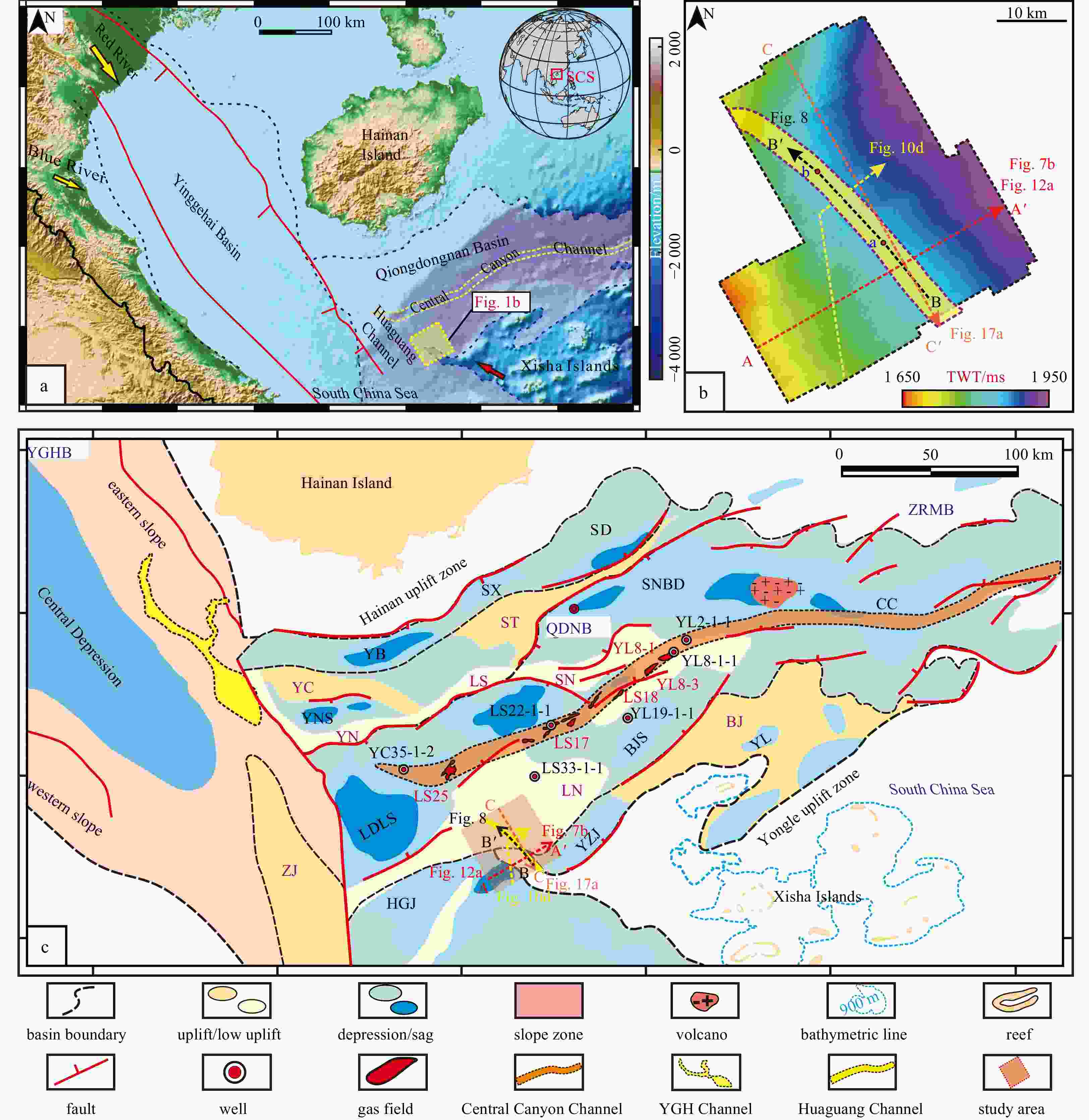
 下载:
下载:
